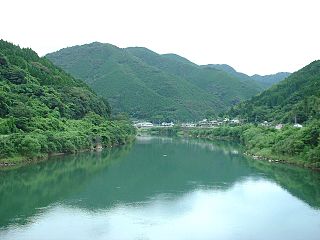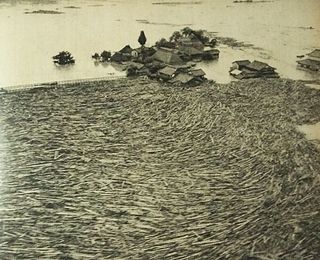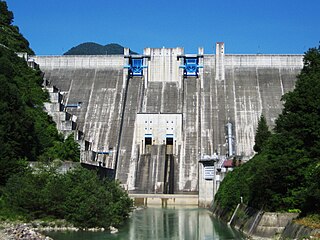
A dam is a barrier that stops or restricts the flow of surface water or underground streams. Reservoirs created by dams not only suppress floods but also provide water for activities such as irrigation, human consumption, industrial use, aquaculture, and navigability. Hydropower is often used in conjunction with dams to generate electricity. A dam can also be used to collect or store water which can be evenly distributed between locations. Dams generally serve the primary purpose of retaining water, while other structures such as floodgates or levees are used to manage or prevent water flow into specific land regions. The earliest known dam is the Jawa Dam in Jordan, dating to 3,000 BC.

The Sepulveda Dam is a project of the U.S. Army Corps of Engineers designed to withhold winter flood waters along the Los Angeles River. Completed in 1941, at a cost of $6,650,561, it is located south of center in the San Fernando Valley, approximately eight miles east of the river's source in the western end of the Valley, in Los Angeles, California.

A spillway is a structure used to provide the controlled release of water from a dam or levee downstream, typically into the riverbed of the dammed river itself. In the United Kingdom, they may be known as overflow channels. Spillways ensure that water does not damage parts of the structure not designed to convey water.

The Shinano River, known as the Chikuma River in its upper reaches, is the longest and widest river in Japan and the third largest by basin area. It is located in northeastern Honshu, rising in the Japanese Alps and flowing generally northeast through Nagano and Niigata Prefectures before emptying into the Sea of Japan.

The Kuma River is a river in Kumamoto Prefecture, central Western part of Kyūshū, Japan. It is sometimes referred as Kumagawa River. It is the longest river in Kyushu, with the length of 115 km long and has a drainage area of 1,880 km2 (730 sq mi). The tidal flat of the Kuma River estuary is approximately 1000 hectares.

Malampuzha Dam is the second largest dam and reservoirs in Kerala, located near Palakkad, in the state of Kerala in South India, built post independence by the then Madras state. Situated in the scenic hills of the Western Ghats in the background it is a combination of a masonry dam with a length of 1,849 metres and an earthen dam with a length of 220 metres making it the longest dam in the state. The dam is 355 feet high and crosses the Malampuzha River, a tributary of Bharathappuzha, Kerala's second longest river. There is a network of two canal systems that serve the dam's reservoir of 42,090 hectares.

Japan participated in the 2006 Asian Games held in Doha, Qatar from December 1, 2006 to December 15, 2006.

Aburagi Dam (油木ダム) is a dam built upstream on the class-B Imagawa River, located in the town of Soeda, in the Tagawa District of Fukuoka Prefecture, Japan.

The Samanala Dam is a dam primarily used for hydroelectric power generation in Sri Lanka. Commissioned in 1992, the Samanalawewa Project is the third-largest hydroelectric scheme in the country, producing 405 GWh of energy annually. It was built with financial support from Japan and the United Kingdom. It is notable for a large leak on its right bank. Power production continues as planned despite the leakage, and the water from the leak now provides two thirds of the water issued by the reservoir for agriculture in downstream areas.

The 1953 North Kyushu flood was a flood which hit Northern Kyushu, Japan in June 1953. The flood was caused by cloudbursts and prolonged rain from the Meiyu rain front which dropped 1,000 mm of rain over Mount Aso and Mount Hiko. This downpour resulted in the overflow of many of the surrounding rivers, such as the Chikugo River.
Mariko Masubuchi is a Japanese softball player who played as a pitcher. She won the silver medal for Japan in the 2000 Summer Olympics.

The Gōnokawa River is a river that runs through Hiroshima and Shimane prefectures in Japan. It is the largest river in the Chūgoku region. It is also called the Gōgawa River and, in Hiroshima, the Enokawa River.

Japan competed in the 2010 Asian Beach Games in Muscat, Oman from December 8 to December 16, 2010. The delegation was bannered by 46 athletes. Japan send their representatives in 5 sports including beach soccer, beach volleyball, beach handball, sailing, and triathlon.
Prince Yuge was a Japanese prince and waka poet. He was the sixth son of Emperor Tenmu, by Princess Ōe, daughter of Emperor Tenji. His full brother was Prince Naga.
Water supply and sanitation in Japan is characterized by numerous achievements and some challenges. The country has achieved universal access to water supply and sanitation; has one of the lowest levels of water distribution losses in the world; regularly exceeds its own strict standards for the quality of drinking water and treated waste water; uses an effective national system of performance benchmarking for water and sanitation utilities; makes extensive use of both advanced and appropriate technologies such as the jōkasō on-site sanitation system; and has pioneered the payment for ecosystem services before the term was even coined internationally. Some of the challenges are a decreasing population, declining investment, fiscal constraints, ageing facilities, an ageing workforce, a fragmentation of service provision among thousands of municipal utilities, and the vulnerability of parts of the country to droughts that are expected to become more frequent due to climate change.

The Shin-Takasegawa Pumped Storage Station (新高瀬川発電所) uses the Takase River to operate a pumped storage hydroelectric scheme about 12 kilometres (7.5 mi) west of Ōmachi in Nagano Prefecture, Japan. Part of the system is within Chūbu-Sangaku National Park.

The Ōmachi Dam is a concrete gravity dam on the Takase River just west of Ōmachi in Nagano Prefecture, Japan. Construction of the dam began in 1975 and it was completed in 1985. The primary purpose of the dam is water supply and it also supports a 13 MW hydroelectric power station. It is owned by TEPCO.

Tatsuyoshi Masubuchi is a professional Japanese baseball player.
Masubuchi is a Japanese surname. Notable people with the surname include:














